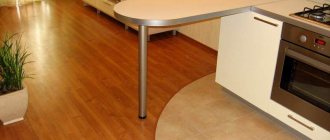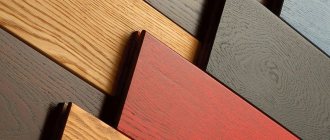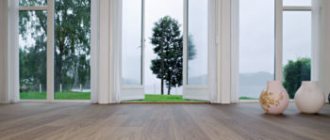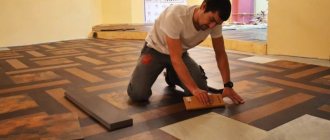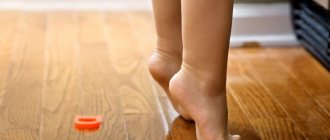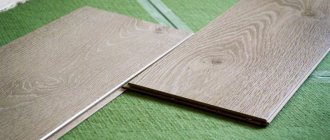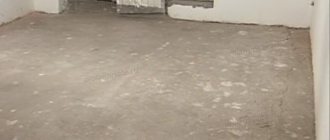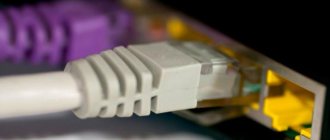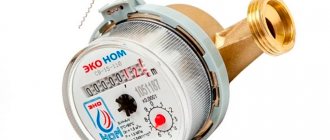Comparative characteristics of laminate and linoleum.
People who are going to do renovations are concerned about the problem of what to lay on the floor: laminate or linoleum? Of course, a definite solution can never be found here, because each of these materials differs in its own qualities and performance indicators.
In addition, the choice of material largely depends on the characteristics of the room - its traffic, the internal humidity of the room, the need for cleaning, the risk of damage, and so on. There is one more point - many qualities of floor coverings may depend on their installation - how it was executed, the use of the substrate. We’ll talk about the subtleties that determine the choice of coating further.
What is the difference between linoleum and laminate?
Let's look at each material in more detail:
- Laminate is a special flooring material. It consists of several durable layers. At the bottom of the laminate there is paper that is not afraid of water, above it there is a hard layer of fiberboard. The next layer is a durable film, which is also not afraid of water. On top of it is glued printing paper with an ornament that imitates laid parquet boards made of valuable wood. The final layer of the laminate is acrylate/melamine resin, which provides the product with resistance to abrasion, color stability, and susceptibility to certain chemicals. The laminate is laid as follows - special locks are joined.
Linoleum or laminate
- Linoleum is significantly different from laminate. As a rule, polymer ingredients are used to make this material, with the addition of special substances. Thanks to these substances, linoleum is resistant to various influences. The material consists of several layers. However, the composition of these layers and purpose are completely different, not like laminate. In linoleum, PVC material is used instead of fiberboard, and the protective function is assigned to especially durable vinyl. Linoleum can be equipped with a fiber base, which increases the thickness of the product and hides surface irregularities. Linoleum is laid like this: the product is glued using glue or a special material that acts as a binder.
Laminate
Many people consider laminate flooring to be a natural floor covering due to the wood fibers present in its composition. This statement can be questioned, since the cellulose fibers are held together by a polymer-based resin. When creating laminate, manufacturers use pressed hardboard slabs. The material acquires a multilayer structure. The base has an additional protective coating on both sides. This function is performed by kraft paper with additional impregnation with phenol or an applied polymer coating. On the front side, acrylic material or melamine resin is sprayed onto the surface, partially preventing the penetration of moisture into the thickness of the material. Laminate does not withstand direct contact with water, but can be easily cleaned with a damp cloth. Special spraying provides additional protection against mechanical deformation.
To answer the question of what is better to lay on the floor: laminate or high-quality linoleum, you need to familiarize yourself with the characteristics of the specific room for laying the linens. Thus, in the kitchen there is a high level of humidity, so laying laminate flooring in such a room cannot be considered the best solution.
The surface protective layer can take on different thicknesses. It determines whether the laminate belongs to a particular strength class. The most stable laminate cannot boast a protective coating thickness exceeding 1mm.
Laminate belongs to the category of block-type floor coverings, which fundamentally distinguishes it from any type of linoleum. During the installation process, small “planks” are to be laid.
The most widely used laminate flooring has wedge latches on all sides. This coating greatly facilitates the installation process, but there are minimal gaps between the blocks. Some experts consider this feature to be a disadvantage of the solution, since moisture can concentrate in the gaps.
Laminate with wedge latches allows you to avoid rigid adhesion of each sheet to the floor plane. When the temperature changes, the canvases do not deform. Adhesive-type laminate is much less common, since its installation is extremely difficult for the master. The canvases are rigidly fastened to the floor plane, and therefore the risk of deformation increases with a sharp change in the thermal conditions in the room. When properly installed, the gaps between adjacent laminate slabs become waterproof. There is also a tongue-and-groove laminate, which is very rare on the modern market. It has a characteristic relief at the ends.
Laminate has a major disadvantage: it is susceptible to moisture. Regardless of whether they belong to one class or another, coatings are not able to withstand the penetration of water into their thickness. As a result of such processes, deformation of the material occurs without the possibility of subsequent recovery. Only damaged elements can be replaced. If the boards are “set” with glue, they will have to be cut out. With wedge-type laminate, it is enough to dismantle the damaged boards and replace them with new ones.
Laminate or linoleum - which is better, cheaper, warmer, more environmentally friendly, more practical: expert opinion
Which of these materials is considered better? In this matter, it is worth taking into account the requirements of the selected premises. If you don't know what to choose, just compare these floor coverings based on the most important parameters.
Insulation performance:
- The thermal insulation qualities and sound insulation qualities of these two coatings are usually determined by the properties of the substrate. Which material is warmer depends on how thick the material is and what it is made of.
- Remember, if linoleum is laid, then the substrate is only an addition, the use of which is not always necessary.
- If laminate is installed, then the underlay is a mandatory element. Among the huge range of linoleum, the warmest is considered to be the type that is equipped with a compacted felt or fabric base.
- Due to its own plasticity, linoleum tends to better absorb various extraneous sounds, especially if the material has a soft base.
- If you take laminate flooring, then when you walk on it, knocking noises from shoes and hard soles will be heard throughout the apartment. However, here a good underlay can come to the rescue as sound insulation.
Advantages of laminate
Eco-friendly materials:
- Both laminate and linoleum are considered quite environmentally friendly. They are non-toxic and therefore safe. When comparing environmental friendliness, a problem often arises when disposing of linoleum, because when this material burns, it produces a strong odor and releases harmful substances.
- But, given that owners of houses and apartments do not often dispose of linoleum themselves, this drawback is insignificant.
Transportation:
- Transporting laminate flooring is much easier, since its boards are compactly packaged, and therefore the laminate can be transported in your car, even lifted using an elevator.
- Linoleum rolled into a roll has large dimensions, therefore, in order to deliver it, a truck is needed, and the roll may not even fit into an ordinary elevator for passengers.
Installation and repair:
- Installation of these materials is quite simple and in order to obtain a high quality coating, you just need to follow the instructions. If you take laminate separately, its assembly requires a responsible approach.
- Installing linoleum takes much less time compared to laying laminate, although it requires the use of special glue or double-sided tape. In addition, to lay laminate flooring you need a perfectly flat floor.
- Laminate is a more repairable material. If necessary, it is partially disassembled and some boards are replaced with others. Also, small chips or cracks on the boards can be repaired with a special repair paste.
- Linoleum is not so easily repaired. It needs to be changed all over, as it can get scratched quickly.
By choosing linoleum for laminate, you can not only save on material, but also make installation easier.
Moisture resistance:
- The main distinguishing feature of these materials is moisture resistance. Laminate does not always tolerate strong moisture, but linoleum never loses its properties when water gets on it.
- Note that today you can also find a laminate that is easily considered moisture resistant.
Special performance indicators, appearance:
- Linoleum, which is produced in rolls, does not look as presentable and does not always reliably imitate natural wood. Although in some cases the imitation works perfectly.
- If we take into account the specifics of the application, then we note that furniture and heels leave marks on the linoleum. But laminate is stronger in this regard.
- Laminate flooring can only be washed with a wet cloth, while linoleum can be washed with any available means, there are no restrictions here.
Materials used
The characteristics of linoleum are largely determined by its belonging to one type or another. Natural material has fundamental differences from other solutions in terms of composition, characteristics and price. Manufacturers classify it as a separate category of floor coverings and give it the name marmoleum.
Marmoleum has a jute base on which layers of wood flour and chalk are applied. Resins and oxidized linseed oil act as a connecting link between them. Appropriate natural dyes are used to apply the design. Marmoleum cannot compete with other types of coating due to its high cost.
Nitrocellulose-based linoleum is more common. Among its advantages are increased ductility, low thickness and high strength. Linoleum has a high tendency to burn, so it is not recommended for interior decoration.
Linoleum made of a special plastic - griftal - has a fabric base. Its distinctive features are considered to be high heat and sound insulation characteristics. With prolonged use, linoleum experiences deformation. It stretches out in width and becomes shorter in length.
Rubber linoleum is the undoubted leader in terms of elasticity and resistance to moisture. This allows you to lay the canvas on a base with minor unevenness without much difficulty. Toxicity prevents the use of this material in residential areas.
PVC-based linoleum is actively used in homes and offices. It can be completely devoid of a base or produced on a special backing made of fabric, felt or foamed PVC.
Linoleum or laminate: pros and cons
Repair is not the most pleasant procedure. However, almost all people face it. There comes a time when it is necessary to re-glue the wallpaper in a particular room, repaint the walls, ceilings, and, of course, change the flooring.
Currently, in stores you can find a wide range of variations of floor coverings. All of them will look perfect both in a private house and in a city apartment. However, laminate with linoleum is considered to be the most popular. Before you go to the store for such materials, study their advantages and disadvantages in more detail.
Linoleum:
Linoleum is a covering in the form of rolls, for the manufacture of which polymer materials are used. This material has both positive and negative indicators.
Pros:
- Linoleum is inexpensive.
- This material has a wide range of colors. This makes it possible to choose a floor covering of any style.
- Installation of the material is easy. Anyone with strong hands can handle this kind of work by laying a covering in a small room.
- The material has low thermal conductivity, therefore, a floor covered with linoleum is almost never cool.
- The coating does not disappear because it does not have the component that rots. Synthetic materials are used to make linoleum.
- The linoleum floor is not noisy.
- There are linoleums that are practically non-slippery.
- Even the material that does not have anti-slip properties is not very slippery.
- The service life of the material can vary from 30 years to 50. In a word, I laid linoleum and forgot about it for a long time. But, at the same time, it is worth considering one point - over time, the appearance of the material becomes less presentable.
Advantages and disadvantages of linoleum
Cons:
- Linoleum is considered an artificial material. In terms of quality, appearance and environmental friendliness, this material is inferior to natural wood coating.
- Due to the heavy gravity, noticeable marks often remain on linoleum.
- Cheap types are very sensitive to extremely high and low temperatures. From high temperatures, linoleum is deformed, from low temperatures it becomes covered with cracks.
- Many linoleums look cheap. But here it is necessary to take into account the fact that modern types of well-known companies often imitate: natural wood, tiles... And what’s most interesting is that such imitation often looks realistic.
Laminate:
Pros:
- Some types of laminate are inexpensive when compared with modern ceramic tiles or parquet
- Has a lot of different colors, sometimes realistically imitating a wooden floor
- Installing laminate flooring is simple. The material is not glued, installation occurs using the “lock” method
Advantages and disadvantages of laminate
Cons:
- The service life of an ordinary laminate may not exceed more than 5 years if it is laid in a room with high humidity.
- Laminate is considered an artificial material, which is significantly inferior to natural ones.
- The top layer of the laminate is often damaged, for example, when a sharp or heavy object falls.
- With improper care or frequent washing, laminate flooring can lose its pleasant appearance. As a rule, this results in permanent, light-colored stains.
- Even if the laminate is laid correctly, the seams are not always airtight. Consequently, water, dust, and dirt will penetrate into the joints. Because of this, the coating will begin to deteriorate over time, becoming mobile and creaky.
- If such a coating is ever flooded with water, it will most likely have to be replaced.
Linoleum
Linoleum belongs to the category of rolled floor coverings with its characteristic moisture resistance and moisture resistance. The material is absolutely not afraid of wet cleaning with or without detergents. Provided that the installation technology is strictly followed, the laminate can retain a small amount of liquid and prevent leakage. When choosing which is better - laminate or linoleum, the expert’s opinion will be based on the combination of product characteristics and room features.
What is better to lay: laminate or linoleum in an apartment, house, kitchen, country house, balcony?
Have you decided to renovate? Or maybe you are worried about what kind of flooring to lay on the balcony? Let's take a closer look at these issues.
Apartment and private house:
- Living room. This room is considered the most central in a house, apartment or country house. Of course, laminate looks more beautiful here, since it has a more presentable appearance. If you take linoleum, no matter how practical and modest it may be, it will not fit perfectly. The living room, as a rule, is obliged to make an impression on the people who come. Many guests gather here, holidays are held, therefore, with its appearance, this room should demonstrate the taste and financial capabilities of the owners. Only laminate can meet these conditions.
- Bedroom. It is better to lay laminate flooring in this room, since the bedroom does not have great practical significance. Dirt and moisture never collect here, therefore cleaning is not so frequent. Laminate can highlight the beauty of the bedroom, especially if it is light.
- Hallway. Only linoleum is suitable for the hallway, since dampness and dust from the street first penetrate into this room. The material that is easy to care for can protect the floor covering.
Coverage depends on the room
Kitchen:
- If you decide to buy flooring for your kitchen, then first of all think about the moisture resistance of the material. There is usually a lot of water vapor in this room. It occurs during cooking and washing dishes. It is also very common for water to end up on the floor due to spills.
- If you take these conditions into account, then choose linoleum for the kitchen. This material is more practical, more functional, it is not afraid of water. Laminate is not used to such influences. Cool water may cause warping on laminate flooring.
- Linoleum has other consumer advantages. If one of the pipes bursts, you will not be able to flood the neighbors who live below you. Linoleum simply will not allow water to escape anywhere. When wet, you will need to turn this floor covering over and dry it thoroughly.
Moisture is destructive for laminate, so linoleum is preferable in the kitchen
. Balcony:
- For a loggia or balcony, linoleum is considered the ideal floor covering. For example, you forget to close the window on the balcony, as a result of which the laminate will deteriorate, but nothing bad will happen to the linoleum. And floors covered with this material always seem warmer. But keep in mind that in severe frost, linoleum tends to crack.
- If you still want to put laminate flooring on your balcony or loggia, choose the type that has a class of 33. Such products can withstand heavy loads and practically do not wear out.
- If you plan to put flowers on the balcony, try to insulate the floor in the places where the pots will be placed. Do the same with the places where the laundry will dry. It is advisable not to lay laminate in such places.
Classification of floor coverings
Depending on the type of load and purpose of the room, both types of products are divided into classes, which are marked with numbers. Their main difference is the thickness of the protective layer (indicated in parentheses). The parameter must be specified in the technical specifications. It must be taken into account when choosing the type of floor.
Domestic:
- 21 (0.15 mm) Fits in rooms that are rarely used - wardrobe, closet, bedroom.
- 22 (0.20 mm) Suitable for constant presence of people in the room - kitchens, living rooms, offices.
- 23 (0.25 mm) Used under conditions of increased loads, for example, if many people live in a house. Suitable for corridor, kitchen or hallway.
Commercial:
- 31 (0.35 mm) Spread in rooms with little traffic - meeting rooms, hotel rooms.
- 32 (0.45 mm) Used for average wear in reception areas or offices with up to 25 workers.
- 33 (0.55 mm) Placed in high traffic areas - corridors, classrooms.
- 34 (0.80 mm) Suitable for very high wear rates - shopping pavilions, airports, train stations.
Despite their strength characteristics, they are all designed for normal operating conditions. When you need to get special properties, for example, choose the option that is warmer, you should pay attention to special coatings:
- antibacterial;
- anti-slip;
- acoustic;
- antistatic.
What to choose: advice from experienced people
- If we compare the external characteristics of these materials, then both laminate and linoleum have a fairly wide range of color palettes. You can choose any of these two coatings with imitation of natural wood, stone, and so on.
- Laminate is considered more environmentally friendly. It practically does not cause an allergic reaction. As for linoleum, it is to some extent inferior to laminate in this indicator. Although both the first and second options are synthetic. Even if you don’t take into account the fact that waste lumber and polymer components are used to make the laminate.
Choose coverage according to your preferences
- Many argue that the service life of linoleum is much longer than the service life of laminate. Inexpensive laminate, for example, class 32, deteriorates after 5 years. If you take a higher class, it will last about 10 years, if not more.
- Laminate flooring requires careful maintenance. He is more picky in this regard. It does not tolerate water or various contaminants. He also doesn't like scratches or chemicals. Linoleum is not afraid of water, of course, if there are no joints. In those places where joints are still present, you need to be extremely careful, especially if the edges are not welded. This material also reacts very strongly to heels and pet claws.
- These two materials have excellent thermal insulation and sound insulation. It all depends on how thick they are.
Decide for yourself what is best to choose for your own home. Most importantly, do not forget about the balance between price and quality in this choice. Because high-quality linoleums can even be much better than inexpensive types of laminate. But in price they will be almost the same.
Types of linoleum
Whether linoleum belongs to one class or another determines its strength characteristics, wear resistance and other parameters.
Household linoleum remains the most budget-friendly solution. Most often it is represented by a multilayer material based on foamed PVC. Additionally, linoleum contains a decorative layer and a special protective coating. The total thickness of the layers rarely exceeds 4 mm. The linoleum base is quite soft and has a short service life.
Semi-commercial linoleum is an improved prototype of household linoleum. Its strength characteristics are higher, and its thickness reaches 7mm.
Commercial type linoleum is designed for high traffic areas and has maximum wear resistance. For most models, the surface has an additional anti-slip coating to prevent injuries during operation. The question of what is better to lay: laminate or linoleum is decided for a specific room.
Specialized linoleum is manufactured according to the specific requirements of the room. There are sports coatings with a polyurethane base, medical linoleums with a bactericidal surface layer. No less popular are solutions for music studios with increased sound insulation. The surface of the material can be embossed to prevent slipping even on a wet surface.
Feedback on the materials discussed
Leonid:
“I live in an old house, so during the renovation I decided to spend a lot of money on flooring. In my case it was laminate. I had to level the floor, since the floor must be perfectly level to install laminate. In addition to this minus, I would also like to note that after 3 years, chips appeared on the floor in some places from something heavy. Perhaps while rearranging furniture. Soon I want to change the laminate to linoleum. I think it will last longer in my home.”
Irina:
“It is important when purchasing that the choice is correct. For my kitchen I chose expensive linoleum. Having installed it 3 years ago, I do not regret my choice. The renovation in my apartment was done by a team of specialists. They were able to lay linoleum very quickly and efficiently. I believe that there is simply no better and higher quality material today.”
Stanislav:
“We removed the usual linoleum in the kitchen, and after that we breathed a sigh of relief. Somehow I got a little tired of this material. I wanted something more fashionable. It was cool to walk on it barefoot; regular washing of the floor caused marks, scratches, and abrasions. Laminate, even in the kitchen, is a great option. Every family member liked him. Over the 5 years of operation, the floor has hardly changed. There are no chips, no damage. The color remains simply gorgeous. We decided never to return to linoleum. If you also decide to renovate, don’t save money. Buy quality laminate flooring and you won’t regret it.”
